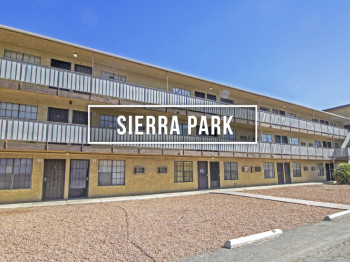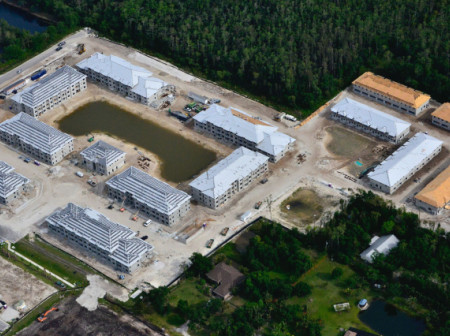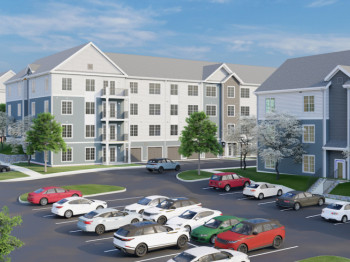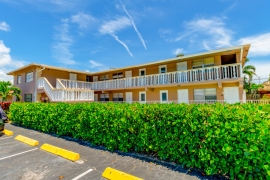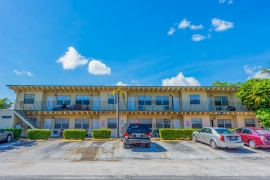Trending Multifamily News
Pompano Beach, Fla. (January 6, 2020) – Franklin Street brokered the sale of Pinecrest Pointe Apartments, a 48-unit rental property located at 295–395 SW 15th Street in the city of Pompano Beach, just to the north of Fort Lauderdale, Fla.
Franklin Street’s South Florida multifamily investment sales team, which included Dan Dratch, Greg Matus and A.J. Stanford, represented the seller and the buyer, both local private investors, in the $6.15 million transaction. The asset traded for $128,125 per unit. Franklin Street Insurance Services’ Ryan Cassidy and Evan Seacat insured the asset.
“This sale achieved a top of the market price in terms of price per unit,” said Dratch, senior associate for Franklin Street. “The asset received multiple offers immediately after hitting the market, which is a clear signal that investor interest remains high for value-add apartment properties.”
Pinecrest Pointe is conveniently located on the border of Fort Lauderdale and Pompano Beach, and offers direct access to major roadways including S. Cypress Road, US 1 and I-95. The property features recent upgrades including new tile flooring, renovated kitchens and bathrooms, roofs, HVAC system, exterior plumbing and a security camera system.
Michael Shadeed, Director for Franklin Street Insurance Services, is nationally recognized expert in risk management, service, brokerage placement, and program administration for the commercial real estate industry. He recently answered some frequently asked questions on how specialized insurance services can reduce the inherent risks associated with the affordable housing sector.
1. Are there any unique risks or complex insurance coverage needs that real estate owners, developers, investors and managers should be aware of concerning affordable housing?
Yes, these risks involve Low-Income Housing Tax Credits (LIHTC) first party insurance or tax credit recapture coverage. It provides indemnification for tax credits that are wholly or partially unavailable at the end of the year. Coverage for loss includes interest or penalties assessed by the Internal Revenue Service on recapture amounts. Also, LIHTC Professional Liability Insurance is a stand-alone professional liability policy that responds to the ownership structure of LIHTC real estate developments and provides indemnity coverage for damages the limited partner(s) incurs as a result of an error or omission of a general partner. A standard indemnity and defense policy will offer coverage for third party claims alleging negligence available to all insured partners. Damages could include loss of LIHTC, as well as interest or penalties assessed by the IRS on recapture amounts.
2. What role does risk management play in the success of an affordable housing project?
Due to the high degree of compliance within this space, we view the affordable housing and tax credit industry as an industry vertical that pays a high level of attention to life safety and deferred maintenance issues. Our biggest impact from a risk management standpoint is the relationship with tenants and improved safety at locations.
3. What are some potential underwriting issues that policyholders need to consider when evaluating insurance programs?
First, you should ask whether this carrier specifically accepts your type of affordable or tax credit housing. Many carriers have warranties and exclusions on their policies for a percentage of affordable or tax credit housing per location. The quality of security and attending to a safe tenant base is also a major factor.
4. Share an example of how an affordable housing project can benefit from a custom insurance solution.
We have manuscript coverage within our property policies, specifically written to include coverage or conditions not included in a standard policy. These types of policies cover the loss of tax credits due to a covered cause of loss, as well as the coverage for recaptured tax credits in arrears at the time of assessment. This coverage complies with state laws and allows for the mortgage of the loan plus equity to be insured, above and beyond the replacement cost value of the asset.
5. How can commercial property owners mitigate risks associated with non-compliance of tax credit rules and regulations related to Low-Income Housing Tax Credits?
There is a significant difference between non-compliance to lose tax credits and losing them because your units are not rentable at the beginning of the year when tax credits are assessed. Non-compliance exposure is when your organization is negligent in their professional duties and is an errors and omissions (E&O) insurance exposure. Professional lines insurance coverage is very expensive. You can lose tax credits due to a covered cause of loss, this is covered in the business income and extra expense exposures. We typically use a manuscript policy form that covers this issue for our clients.
Michael Shadeed is a Director for Franklin Street Insurance Services. He can be reached at This email address is being protected from spambots. You need JavaScript enabled to view it..
Michael Shadeed, Director for Franklin Street Insurance Services, is nationally recognized expert in risk management, service, brokerage placement, and program administration for the commercial real estate industry. He recently answered some frequently asked questions on how specialized insurance services can reduce the inherent risks associated with the affordable housing sector.
1. Are there any unique risks or complex insurance coverage needs that real estate owners, developers, investors and managers should be aware of concerning affordable housing?
Yes, these risks involve Low-Income Housing Tax Credits (LIHTC) first party insurance or tax credit recapture coverage. It provides indemnification for tax credits that are wholly or partially unavailable at the end of the year. Coverage for loss includes interest or penalties assessed by the Internal Revenue Service on recapture amounts. Also, LIHTC Professional Liability Insurance is a stand-alone professional liability policy that responds to the ownership structure of LIHTC real estate developments and provides indemnity coverage for damages the limited partner(s) incurs as a result of an error or omission of a general partner. A standard indemnity and defense policy will offer coverage for third party claims alleging negligence available to all insured partners. Damages could include loss of LIHTC, as well as interest or penalties assessed by the IRS on recapture amounts.
2. What role does risk management play in the success of an affordable housing project?
Due to the high degree of compliance within this space, we view the affordable housing and tax credit industry as an industry vertical that pays a high level of attention to life safety and deferred maintenance issues. Our biggest impact from a risk management standpoint is the relationship with tenants and improved safety at locations.
3. What are some potential underwriting issues that policyholders need to consider when evaluating insurance programs?
First, you should ask whether this carrier specifically accepts your type of affordable or tax credit housing. Many carriers have warranties and exclusions on their policies for a percentage of affordable or tax credit housing per location. The quality of security and attending to a safe tenant base is also a major factor.
4. Share an example of how an affordable housing project can benefit from a custom insurance solution.
We have manuscript coverage within our property policies, specifically written to include coverage or conditions not included in a standard policy. These types of policies cover the loss of tax credits due to a covered cause of loss, as well as the coverage for recaptured tax credits in arrears at the time of assessment. This coverage complies with state laws and allows for the mortgage of the loan plus equity to be insured, above and beyond the replacement cost value of the asset.
5. How can commercial property owners mitigate risks associated with non-compliance of tax credit rules and regulations related to Low-Income Housing Tax Credits?
There is a significant difference between non-compliance to lose tax credits and losing them because your units are not rentable at the beginning of the year when tax credits are assessed. Non-compliance exposure is when your organization is negligent in their professional duties and is an errors and omissions (E&O) insurance exposure. Professional lines insurance coverage is very expensive. You can lose tax credits due to a covered cause of loss, this is covered in the business income and extra expense exposures. We typically use a manuscript policy form that covers this issue for our clients.
Michael Shadeed is a Director for Franklin Street Insurance Services. He can be reached at This email address is being protected from spambots. You need JavaScript enabled to view it..
When it comes to managing commercial property risks, most insurance experts agree that risk management services should be uniquely tailored to each individual client. The International Risk Management Institute defines the term as “The practice of identifying and analyzing loss exposures and taking steps to minimize the financial impact of the risks they impose.” The failure to implement a reliable asset protection strategy could cost you to pay out hundreds of thousands of dollars for bodily injuries and property damages.
Ryan Cassidy and Evan Seacat of Franklin Street Insurance Services share three vital items multifamily property owners and managers should consider when developing loss control prevention strategies.
1. Maintain Accurate Records
Having a proper records management system is critically important and will greatly facilitate your commercial property damage claims. As an owner, you should provide the insurance carrier with a basic property summary, which includes updated details on asset improvements, claims narratives, and a loss history report.
Choose an insurance agency that has a dedicated claims department resource to assist you with the claims filing process. We believe that the key to building an exceptional risk management partnership not only lies in the placement of insurance coverage, but also in the day-to-day oversight of claims. This oversight will help achieve your main objective, which is to reduce the frequency and severity of claims that have a direct financial impact on your bottom line.
Next, you should have a specific risk management procedure for every worst-case scenario, including natural disasters. Be sure to keep all important vendor contracts in a safe place before a hurricane/disaster strikes. It is always a wise idea to have your insurance policies reviewed by a third party for accuracy and to catch any potential coverage holes.
2. Make Appropriate Safety and Property Improvements
Building managers should ensure that their properties are upgraded with fire sprinklers, impact resistant windows and durable roofs. Taking those steps will greatly reduce the number of potential problems that are likely to occur. Also, be sure to add security measures such as cameras, perimeter fencing, locks and guards to protect your property, tenant s and guests.
Slip and fall accidents are a common concern for property owners so make certain sure you take safety precautions and have adequate business liability insurance coverage. Likewise, safeguard your property to address potential assault and battery/theft incidents in parking lots or retail areas.
Tenant demographics (i.e. age, sex, marital status, number of children, cars and yearly income) are another factor to consider when creating a risk management strategy. Property owners and landlords can use surveys in their tenant screening process and help protect their investment by attracting higher quality tenants.
3. Understand Insurance Purchase Options
Commercial owners and buyers have been experiencing sticker shock when they refinance, sell or purchase properties. Insurance premiums have jumped as much as 25% because of the broadened insurance requirements set forth by lenders in recent years. Knowing and understanding lender requirements is a necessity when seeking coverage for natural causes of damages such as flood, hail, hurricanes and wind.
As overall insurance requirements have become stricter, national and local proprietary programs are becoming more common and the level of interest has risen for multifamily property owners. Franklin Street is among the insurance firms that have developed proprietary master policy layered programs that can save property owners thousands of dollars both regionally and nationally while still meeting all lender requirements.
Also, ask your insurance broker to explain the difference between Loss Limit vs. Full Limit programs to know which one is right for your needs. Loss limit policies insure property on an occurrence basis to a limit of the probable maximum loss rather than an actual total property value.
Other ways to save on policy premiums include reviewing your deductible amounts, asking about policy discounts in the form of credits or reduced premiums for property upgrades, and ensuring that all insurance coverage limits are accurate.
Ryan Cassidy is a Senior Director for Franklin Street Insurance Services. He can be reached at This email address is being protected from spambots. You need JavaScript enabled to view it..
Evan Seacat is a Senior Director for Franklin Street Insurance Services. He can be reached at This email address is being protected from spambots. You need JavaScript enabled to view it..
Franklin Street has arranged the sale of Laurana Apartments, a 10-unit boutique multifamily community located at 101 NW 7th Avenue in Pompano Beach, Fla. Laurana Apartments sold for $800,000 or $80,000 per unit, which represented 98 percent of the list price.
Dan Dratch, AJ Stanford and Greg Matus of Franklin Street’s South Florida multifamily investment sales team represented the buyer and seller, both local private investors. Franklin Street’s Patrick Miller and Evan Seacat will insure the asset for the new owner.
“Within the first two weeks of marketing we had several tours and multiple written offers,” said Dratch, senior associate at Franklin Street. “Our team worked with the buyer to have a compressed inspection timeline and close the building in less than 60 days at 98 percent of list price.”
Laurana Apartments is located in the heart of Pompano Beach’s innovation district. The city has identified this area to undergo significant redevelopment through public/private partnerships and incentive programs they will offer to owners and developers. Investors were attracted to this multifamily asset because of the strong in-place cash flow from day one, along with the long-term value growth of the future surrounding development.
“There is no shortage of capital being put to work in these areas that will benefit from long-term redevelopment,” said Matus, senior vice president with Franklin Street. “Ultimately, that will always help us navigate these sales so quickly and effectively for both parties.”
BARTOW, Fla., May 17, 2018 – Franklin Street has arranged a $13.875 million Fannie Mae loan for the acquisition financing of Villages at Laurel Meadows, a 156-unit multifamily apartment property located midway between Tampa and Orlando in Bartow, Florida. Casey Siggins and Ben Miller of Franklin Street’s Capital Advisors division secured the loan on behalf of the buyer, VLM Investors, LLC. The 10-year loan has a fixed rate of sub-4.75 percent and features a 30-year amortization schedule following a significant interest-only period. Franklin Street’s Lonnie Kitchen provided insurance services and the buyer selected Franklin Street Management Services to manage the asset.
“This long-term, fixed-rate loan will allow the borrowers the ability to maximize cash-flows and the value of the property,” said Siggins, director of loan origination for Franklin Street’s Tampa office. “It was an extremely competitive bidding process, and at the end of the day, I believe we found the right loan structure to fit the borrower’s strategy for this asset.”
Built in 2008, Villages at Laurel Meadows is centrally located at 100 Laurel Meadows Drive on the corner of CR 555 and W. Clower Street in Bartow. All the units are two-bedroom townhome-style apartments.

